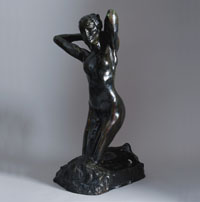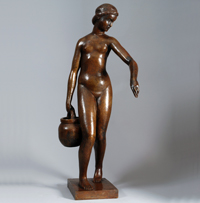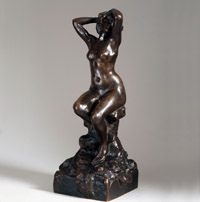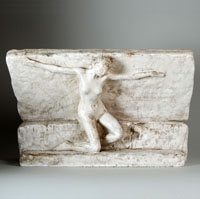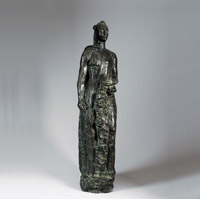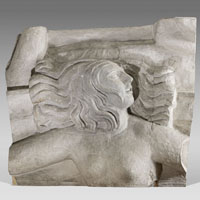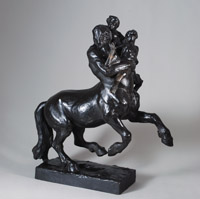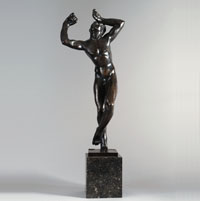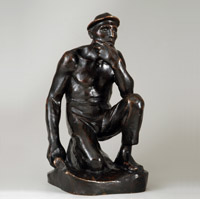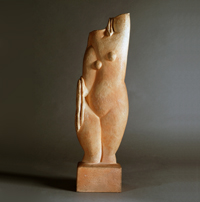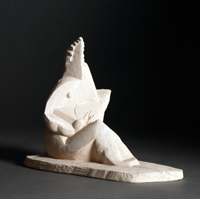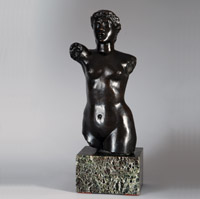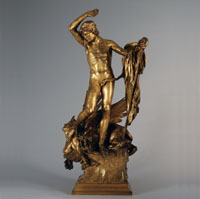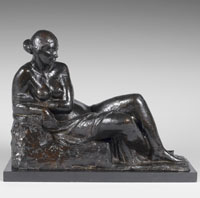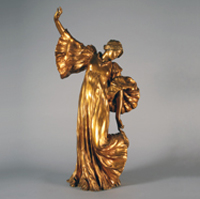20th Century Sculpture
The 20th century sculpture is also showed at our gallery. You will discover here works by Bugatti, Guyot, Petersen, Pompon, Sandoz...
François Pompon (1855-1933)
Pompon was the son of a carpenter and first studied at the Ecole des Beaux-Arts in Dijon. In 1875 he travelled to Paris, where he worked as a jobbing sculptor, whilst pursuing his studies at the Ecole des Arts Décoratifs under the sculptor Aimé Millet and Joseph-Michel Caillé (1836-81); there he also met the animalier sculptor Pierre-Louis Rouillard (1820-81). At the Salon of 1888 Pompon exhibited Cosette (plaster; Paris, Musée Victor Hugo), inspired by Hugo’s Les Misérables. However, until 1914 his livelihood was gained as a sculptor’s assistant. In this capacity he served many of the prominent sculptors of the day, including Rodin. It was his long-term employment with Charles-René Paul de Saint Marceaux that furnished him with the means to pursue his own career as a sculptor of animals. His studies of his Polar Bear (marble; Dijon, Musée des Beaux-Arts) at the Salon d’Automne, that Pompon was acclaimed for his refined simplification of nature. His ability to contain the essential character of creatures in smooth and abbreviated form parallels the more audacious abstraction of Brancusi. The collection of 300 works that Pompon left the French State were eventually installed in the Musée des Beaux-Arts, Dijon, in 1948. The Musée d’Orsay in Paris has a large collection of Pompon’s plaster models.
Bibliography
Galerie BRAME et LORENCEAU, Pompon, rétrospective, 1999.
CHEVILLOT, C. COLAS, L.PINGEOT, A., François Pompon, 1994.
COURIERES, E. des, François Pompon, 1926.
PIA-LACHAPELLE, L., François Pompon sculpteur bourguignon, sa vie, son œuvre, 1988.
Edouard-Marcel Sandoz (1881-1971)
Edouard-Marcel Sandoz learnt under the sculptor Antoine Mercié (1845-1916) and the painter Ferdinand Cormon at the Ecole des Beaux-Art in Paris from 1905. He worked in all mediums including bronze, stone, wood and ceramic. Sandoz’ bronzes are characterized by the use of geometric contrasts, a smooth surface finish and superb patination, influenced by the Art Deco movement. Sandoz is, however, best known for his extensive series of highly stylized porcelain tea and coffee services in the form of birds, animals and children (e.g. Paris, Musée des Arts Décoratifs), first produced by Theodore Haviland in Limoges in 1916-17. From 1921 Sandoz modelled animals for the Porcelaine de Paris Company. The same Company exhibited his Poisson-Chat vase and Chat Debout figures at the Exposition Internationale des Arts Décoratifs et Industriel Modernes in Paris in 1925. Sandoz continued to work for Haviland & Cie, Richard-Ginori in Italy and Langenthal in Switzerland. His sculpture is placed in the 20th century, observing the extreme stylization of his work and the mix of geometric and organic forms, together with a highly personal wit.
Bibliography of Raoul LARCHE
SOCIETE HOSTORIQUE DU RAINCY, François Raoul Larche, 1976.
